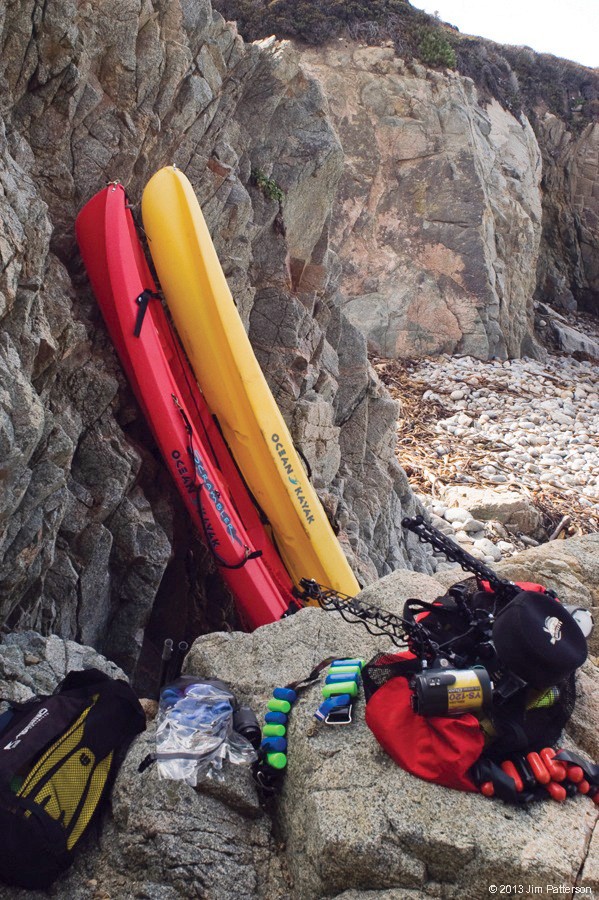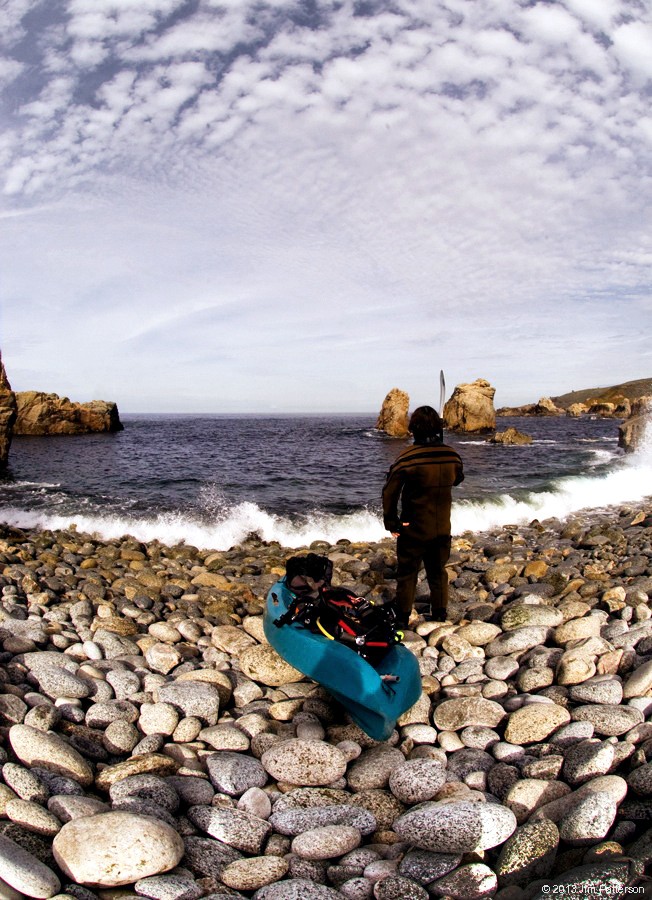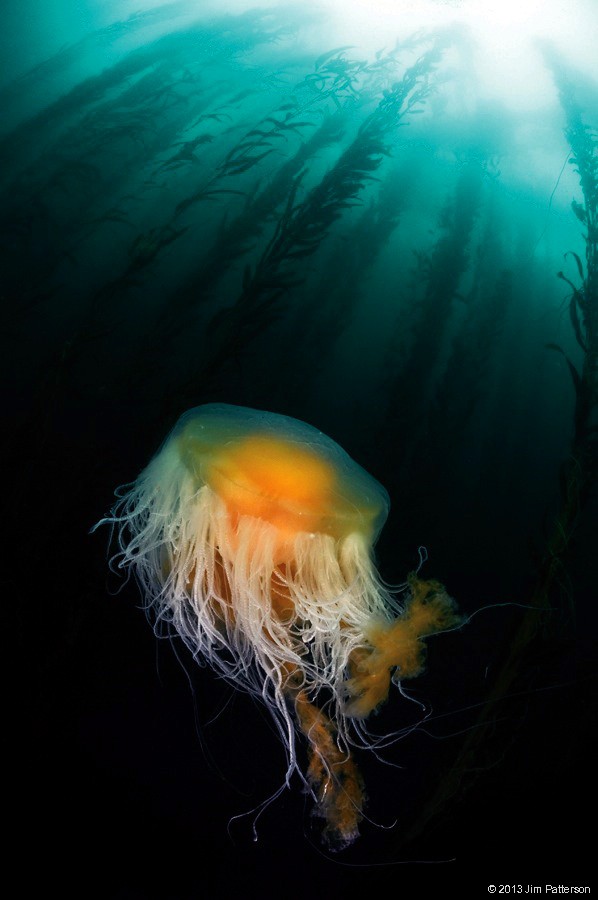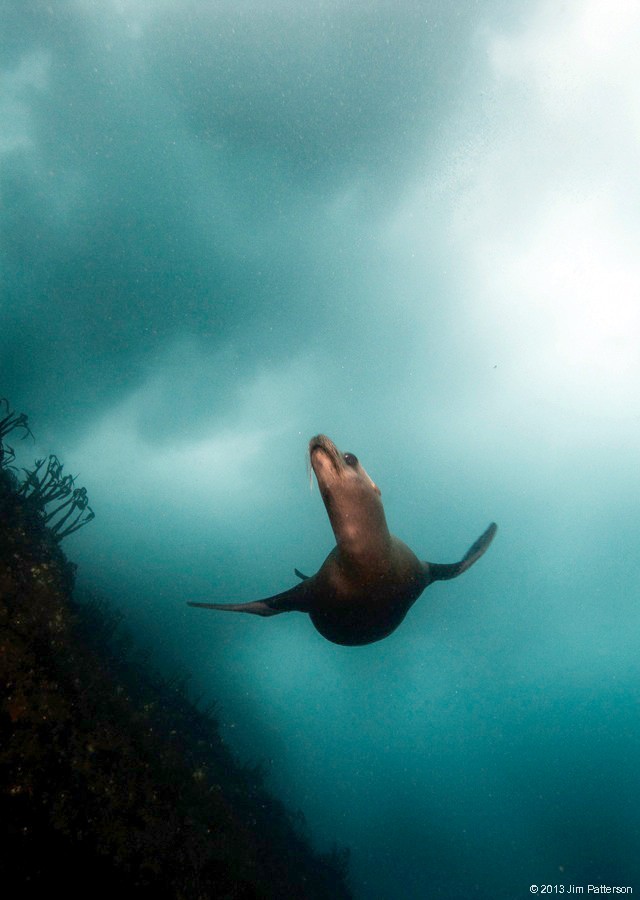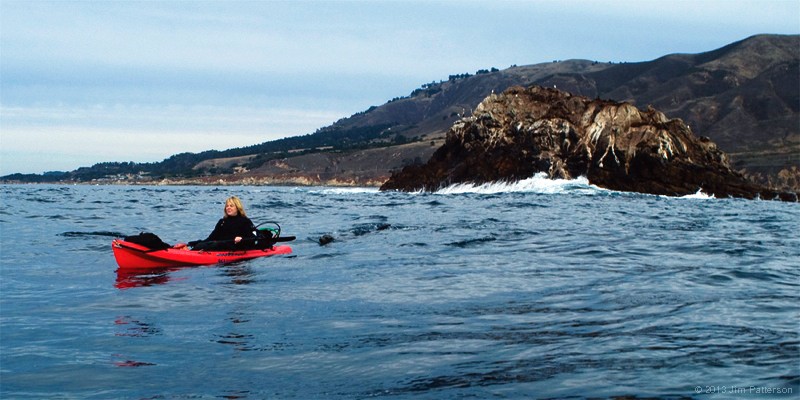As you drive south on Highway 1, the sandy beaches of Monterey and Carmel give way to rocky shores. Passing Point Lobos, Garrapata State Park marks the north entrance to the beautiful, yet rugged Big Sur coast. Offshore is the open ocean, with little protection from the elements of swell and wind. Yet the diving off this stretch of coastline is some of the richest and most diverse Monterey County has to offer, and arguably some of the best in the world.
Story & Photos by Jim Patterson
Situated almost 4 miles south of Point Lobos and 1/2 mile off Soberanes Point, Lobos Rocks are two large granite masses rising off the ocean floor to approximately 40 feet above the surface. They get their name from the barking California sea lions (Zalophus californianus) who call these rocks and cold temperate waters their home. You can often hear them barking while standing onshore, and if the breeze is blowing in, you certainly can often smell them, too. This site is only accessible by boat, or for those of us brave enough (some may call it stupid), by dive kayak. Of the dozen or so times I have been here, only two dives have been done by boat with the rest being by kayak.
Whenever I know I am headed for a dive at Lobos Rocks, my pulse quickens. This is true diving adventure. It’s best to get here early in the day, as winds can easily pick up by mid-morning, even when weather reports don’t predict them. A long dirt pull-out north of Soberanes Point is the best place to park. The trail down to a small cove is marked by a number “7” and consists of dirt and loose gravel, so it is best to leave the flip-flops at home.
Getting down to the cove goes something like this. The first trip includes wearing my weight belt, a backpack bag with camera inside, and carrying my kayak and paddle as far as I can safely go. The kayak is then lowered down a small 15 foot cliff using its bowline. Next comes the time where I do my best mountain goat impersonation and scramble down a short stretch of granite rock to the beach…if you can call it a beach. More often than not, the cove is filled with large, smooth cobble stones the size of cantaloupes from the creek that ends its journey here. When the waves break onshore, the sound of the cobbles rattling around reminds me that a twisted ankle is just one misstep away.
Back up at the car, I don my dry suit and wear my BCD, tank, and regulator while carrying a mesh duffel bag with anchor set-up, mask, fins, snorkel, and hood as well as any safety equipment such as signal tubes, current line, and marine radio in case of emergency.
Once down to the beach, the kayak is loaded and it’s time to enter the water. If any waves are breaking on the beach, timing is of the essence, and when the moment arrives, there is no hesitation. Once safely past the surf, my dive buddies and I exchange stories of past trips here. The epic ones mix with the harrowing tales of narrow escapes.
Once out at the site, it’s time to evaluate if any current is present. You never know when one can come up, especially along the Big Sur coast. The easiest way to do this is to observe the kelp beds to the south side of the rocks. If the kelp beds are straight up and down with a dense canopy, typically the current is down. If the canopy is non-existent, look to see if the kelp is underwater at an angle. On a calm day I will tie my kayak to the kelp and throw my anchor and line as added insurance, just in case the current comes up during the dive. Under this kelp forest, the diving includes pinnacles with cracks and canyons worthy of exploration. And if the visibility is down, this is usually a good place to explore.
Of the many options at this site, the main draw is diving directly off the outer edge of the offshore rock. One of my favorite dives starts with dropping in south of Lobos Rocks and heading north until I reach the wall formed by this massive granite monolith. The wall drops to approximately 140’ into a sandy bottom, so watch your depth. Patches of white plumose anemones (Metridium farcimen) dot the reef and there are several cracks and shelves loaded with strawberry anemones (Corynactis californica) and the larger fish-eating anemones (Urticina piscivora). Patches of pink, purple, and orange hydrocoral (Stylaster californicus) can also be found and be sure to look for cryptic crabs, shrimp, and fish that hide in their recesses. In the shallows, giant green anemones make their home, contrasting beautifully with the oranges and reds of the reef. Just be aware of your surroundings as there can be some serious surge up against the rocks. Schooling rockfish (Sebastes spp.) can be seen hugging the reef, and some lingcod (Ophiodon elongatus) and cabezon (Scorpaenichthys marmoratus) can be found here, but larger fish life is somewhat scarce, most likely due to the local sea lion population keeping them in check. As well, be sure to always keep an eye towards blue water as pelagic drifters often can be seen here.
And if the small stuff isn’t enough to keep you interested, the strong possibility of sea lion interaction certainly will keep the dives here full of excitement. On a number of occasions, I have spent my entire dive between 15-40 feet as large groups of curious sea lions come to investigate this supreme air wasting bubble blower. At times they will keep their distance, but if their curiosity is peaked, be prepared for an underwater ballet as they swoop in at top speed to show off their acrobatic prowess.
I distinctly recall my first dive here. The visibility was phenomenal, as can often be the case here, especially in fall and winter. I turned to check on my two dive buddies and practically spit my regulator out with laughter. Each of them had at least 6-10 orbiting sea lions behind them. I tried to get their attention, to communicate that they should look behind them. Then, I thought to myself, ‘hey, what’s behind me?’ I turned around and I was not alone. I had my own personal entourage of pinnipeds.
Lobos Rocks is a phenomenal dive site, but the days are rare when it can be dove. If you are an experienced kayak diver, find a buddy who has been there before and go have an adventure. But your best bet is to watch the weather and book a charter and ask them to go to Lobos Rocks. You won’t be disappointed!
Story & Photos by Jim Patterson
Jim is an accomplished photographer based in Santa Cruz and has regularly contributed to California Diver. See his website at jimpattersonphotography.com and be sure to check out his upcoming photography workshops.
Dive Site Details:
Location: About 4 miles south of Point Lobos along Hwy 1 and ½ mile off Soberanes Point
Access: It’s a long swim, and with the entry/exit and potential for foul weather and currents, it’s best to get there by kayak or better yet, a charter boat.
Skill Level: Intermediate to advanced for boat diving and advanced for kayak diving.
Depths: 30-140’
Best Season: Summer for calm weather, fall and winter for best visibility.
The Pros: Wide diversity of sea life from macro to big animal. Topography ranges from pinnacles to walls.
The Cons: Difficult to access if not by boat. Susceptible to wind, swell, and current.

